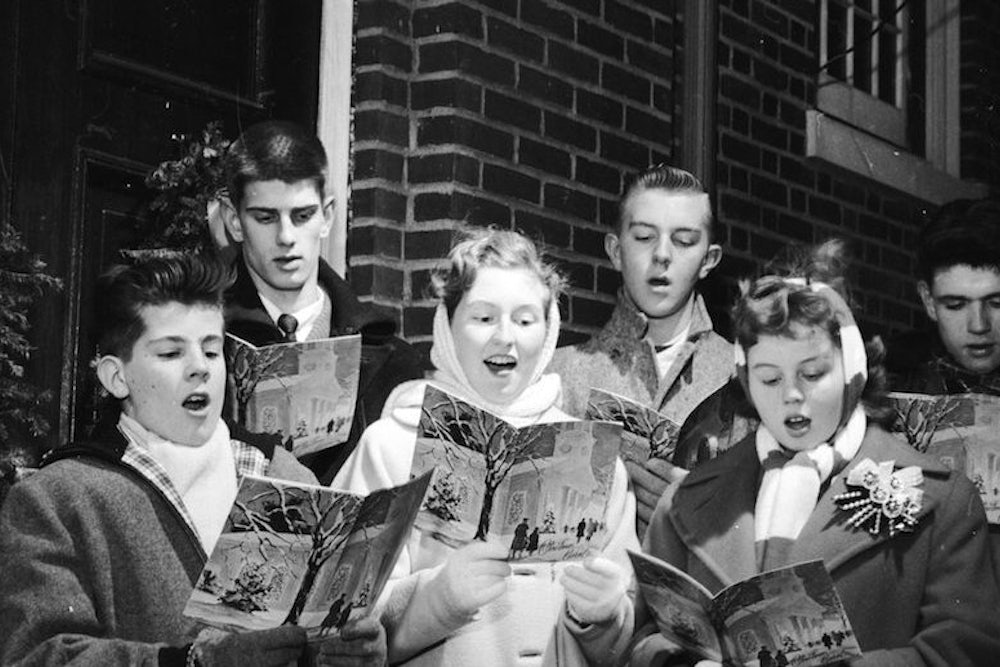It’s difficult to imagine today, but there was a time when “Silent Night” was not virtually synonymous with Christmas. As recently as the nineteenth-century, Christmas was not widely celebrated in the English-speaking world. The Puritans ignored it because the Bible was silent on the topic, while New Year’s was the traditional day of gift-giving in Britain. Carols, though, were popular, and the first significant collection of carols was published in 1833. Though it contained classics like “The First Nöel” and “God Rest Ye Merry Gentlemen,” it, and its 1852 successor, make no mention of “Silent Night.”
That changed with the Victorians. When the German-born Prince Albert married Queen Victoria, he brought many of the traditions of his native land to Britain, including the Christmas tree, gift-giving, and cards. In 1848, the Illustrated London News published a drawing of the royal family celebrating the holiday around a Christmas tree, and the practice quickly caught on around the country. Victoria and Albert also presided over the revitalization of many carols, setting old words to new music. It is probably during this period that many British people were first introduced to “Silent Night.”
The song we know as “Silent Night” was born as “Stille Nacht, heilige Nacht” in a small Austrian village in 1818. According to legend, the church organ was broken on Christmas Eve, so the organist and town priest collaborated to create the carol with a guitar accompaniment in order to ensure that the people of Oberndorf did not go without music on the holy night. The song was translated to English by an American Episcopal priest in 1859.
Though Christmas had become a national tradition by World War I, “Silent Night” was far from the dominant song of the season. But by the time of the famous 1914 Christmas truce—100 years ago this Christmas—the carol played a crucial role in bringing about the temporary break in the fighting. All along the trenches, two sides started singing carols at each other. After the musical icebreaker, some of them met in No Man’s Land, exchanged presents, and played makeshift soccer games.
Legend has it that “Silent Night” was the only carol the two sides had in common, but in reality the Germans were much more familiar with the carol. They were the ones who most frequently sang “Stille Nacht,” while the English responded with a variety of tunes, from “Good King Wenceslas” to “The First Noel.” One rifleman, Graham Williams, wrote later that the Christmas truce “was actually the first time I heard this carol [“Stille Nacht”], which was not then so popular in this country as it has since become.” Williams was not alone in his unfamiliarity with “Silent Night.” Robert Graves called the carol “Stilly Nucked” in his 1962 short story, “Christmas Truce,” suggesting that it was relatively unfamiliar to the soldier-protagonist as well. The two sides bounced carols back and forth until “O Come All Ye Faithful” united them, since the Germans knew the words in Latin. “And I thought, well, this was really a most extraordinary thing,” wrote Williams “two nations both singing the same carol in the middle of a war.”
Christmas music in general took off in the two decades after World War I, coinciding with the rise of radio and the music industry. Bing Crosby, whose Christmas album is one of the most popular of all time, first recorded “Silent Night” in 1928. In the almost nine decades since, the song has been recorded and re-recorded by countless artists. Time magazine found that “Silent Night” is by far the most recorded carol in America since 1978, outstripping runner-up “Joy to the World” almost two to one. A 2010 study showed that the same applied to Britain. Of the top 10 highest-selling Christmas albums of all time, no less than seven feature the song. (Celine Dion and Barbra Streisand are the only two artists who passed.)
In 2011, UNESCO declared “Silent Night” part of our “intangible cultural heritage,” but 100 years ago, it wasn’t nearly the cultural fixture it is today. Since it’s humble origins in an Austrian village almost 200 years ago, the song has come a long way, featured on countless recordings and helping to bring together nations entrenched in the bloodiest war in modern history.
